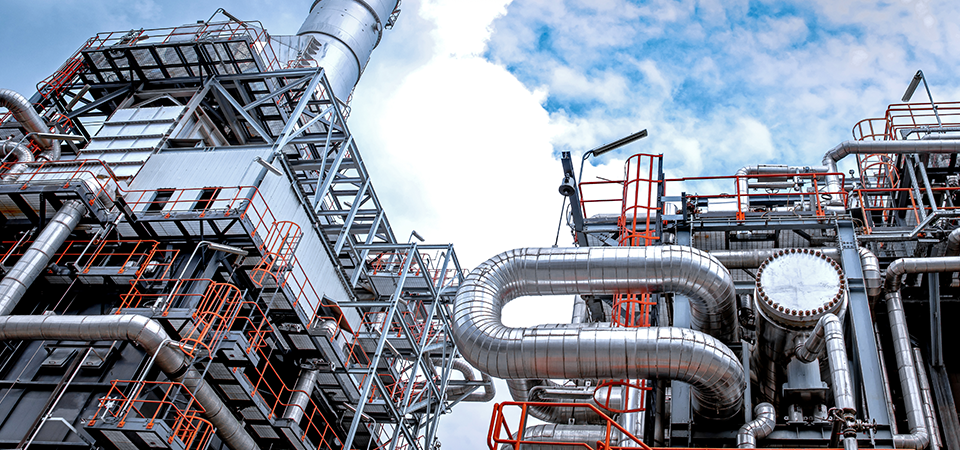Refinement of crude oil into the products and fuels we depend on is incredibly complex. Harmful and highly-regulated volatile organic compound (VOC) emissions often pollute the air near these sites. But it’s not just air quality refineries need to preserve.

Some refining stages require water—either fresh water in direct contact with crude oil or reused water to cool products after heat-intensive processes. Either way, water pollution is the result.
Habitats, wildlife, water quality and people are put in jeopardy if this wastewater is dumped into the environment. To comply with environmental statutes, facilities must either fully treat this wastewater or treat it enough to safely comingle with outside wastewater destined for municipal treatment.
It is during the treatment of this polluted water that BioAir Solutions can help eliminate pollutants. Our equipment strips the compounds from polluted water streams via degasification and then eliminates those compounds, or other gasified compounds, using biological and physical treatment of the resulting impacted air. We cover that process in a separate article.
Below, we discuss refining operations commonly responsible for water pollution.
Desalting
This early-stage process removes brine from crude oil. The brine can cause corrosion of refining equipment if it’s not addressed. The process starts by injecting fresh water into the crude oil. This water mixes with the brine in the oil, decreasing the overall concentration of salt via dilution.
Then, the oil is dehydrated and sent on for further refinement. Due to its contact with the crude oil, the briny water is also impacted with VOCs that must be treated.
Fluid catalytic cracking
This late-stage refinement occurs in the production of gasoline, butane, propane and other “lighter” fuels. It’s a chemical reaction meant to break crude oil’s larger molecules into smaller ones.
The catalyst is typically made up of powdered silica and alumina. It’s fluidized using hot vapor and then is mixed with crude oil under high heat, causing the long-chain crude molecules to “crack” into smaller ones. Because each of the desired fuels that result from fluid catalytic cracking has a different boiling point, the fuels vaporize one by one and are collected. They’re then separately re-condensed using cooling water that must be treated if it’s polluted during the process.
Steam stripping also occurs during fluid catalytic cracking to recover remnant product from the spent catalyst. This also results in polluted water that must be treated.
Hydrocracking
This process combines the fluid catalytic cracking process with hydrogen to produce cleaner-burning gasolines, diesel fuel and jet fuel. Again, the long-chain crude oil molecules are cracked into smaller molecules. Hydrogen is added because it increases the yield of the desired short-chain molecules.
Catalytic hydrodesulfurizing
Crude oil and natural gas typically contain sulfur, which is heavily regulated around the world. Catalytic hydrocracking is integral to the production of ultra-low sulfur diesel fuel and fuels used in aviation, maritime and power generation applications. In addition, removing sulfur is important because even in small concentrations it can poison the catalyst metals used in catalytic reforming (which is described below).
Crude is vaporized under high pressure and high heat and then sent to a reactor where it meets the catalyst (usually aluminum-based with additive cobalt and molybdenum). Then, pressure is reduced and the vaporized materials pass through a gas separator. Off-gases (including hydrogen sulfide, H2S) are sent away for treatment and recycling. The resulting materials include methane, ethane, butane and propane in addition to the low-sulfur fuel product.
As with other refining processes, reused water is used in the cooling process.
Catalytic hydrodesulfurizing
Crude oil and natural gas typically contain sulfur, which is heavily regulated around the world. Catalytic hydrocracking is integral to the production of ultra-low sulfur diesel fuel and fuels used in aviation, maritime and power generation applications. In addition, removing sulfur is important because even in small concentrations it can poison the catalyst metals used in catalytic reforming (which is described below).
Crude is vaporized under high pressure and high heat and then sent to a reactor where it meets the catalyst (usually aluminum-based with additive cobalt and molybdenum). Then, pressure is reduced and the vaporized materials pass through a gas separator. Off-gases (including hydrogen sulfide, H2S) are sent away for treatment and recycling. The resulting materials include methane, ethane, butane and propane in addition to the low-sulfur fuel product.
As with other refining processes, reused water is used in the cooling process.
Complementing your refinery wastewater treatment
As noted in the examples above, water is used in a variety of refining processes. The extent of refinery wastewater treatment depends on the extent to which water is polluted by VOCs or other compounds.
Fresh water is necessary for processes that call for direct contact with crude oil or oil derivatives, but water purity is not an issue in cooling or re-condensing stages. Refinery wastewater treatment is as much about recycling water for reuse as it is cleaning it up enough for compliant discharge into the environment.
BioAir Solutions is an industry leader in eliminating emissions that impact oil refinery wastewater. Our multi-step treatments include the installation of an integrated system that starts with degasification of wastewater. It’s followed by biological (and sometimes also physicochemical) treatment of polluted airstreams that result from degasification.
We discuss the way such a system works in this in-depth guide. You can also learn about the start-to-finish process of identifying and treating emissions via our BioAir Complete® program. Then, contact us if you want to talk through any specific challenges at your site.
